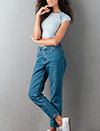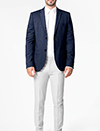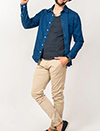Mastering Smart Casual in 2023: A Contemporary Guide for Modern Men
Smart casual, the elusive dress code that raises eyebrows and elicits questions. It's a style that demands a careful balance between smartness and casual comfort. When executed correctly, smart casual exudes confidence and sophistication, seamlessly transitioning from the office to a date. However, one wrong move can leave you looking uninspiring or like you've haphazardly thrown on a suit jacket over jeans. It's an art, but it's a worthwhile one to master.

What Exactly Is Smart Casual?
Smart casual, to be perfectly honest, is a bit perplexing. It brings together two contradictory terms and asks you to bridge the gap. Do you lean toward the 'smarter' side or favor 'casual'? The truth is, it's open to interpretation, leaving ample room for personal style. You can take it literally by combining smart and casual elements, like a blazer with jeans or a T-shirt tucked into tailored trousers. Smart casual often comes into play at events with a degree of sophistication but a laid-back atmosphere, like relaxed weddings or upscale dinners.
Variations of Smart Casual
The meaning of smart casual varies based on where you're going and who you're going with. For events like graduations, where formality and respect are paramount, opting for a blazer is a safe choice. Meanwhile, a date might call for a more relaxed approach, like tailored trousers, desert boots, an untucked Oxford shirt, and a bomber jacket.
Distinguishing Casual from Smart Casual
Casual dressing requires little thought – jeans and a T-shirt or even sweatpants and a hoodie. Smart casual, on the other hand, demands an additional touch of formality. It necessitates an item of clothing, typically formal, that elevates the look beyond just being casual, such as pleated trousers, a button-down shirt, or a cashmere sweater.

Smart Casual Styling Tips
- Keep It Simple: Stick to classic essentials like dark denim jeans, chinos, Oxford shirts, unstructured navy blazers, and simple knitwear. Understated smart casual often works best.
- Complementary Colors: Pair separates thoughtfully. Combine muted, complementary colors, like classic grey wool trousers with a navy blazer and a white shirt. Earthy tones, including green, stone, and brown, offer a less obvious choice.
- Attention to Details: Nail the finer points of smart casual wear. Ensure trousers are the right length, keep leather shoes clean or polished, and match your leather accessories to avoid clashing.
- Start with Casual: Build your smart casual look from a casual foundation. Begin with a casual outfit and swap one or two pieces with more formal items. For example, replace a hoodie with an unstructured blazer.
Key Smart Casual Pieces
1. Oxford Button-Down Shirt: Versatile and timeless, the Oxford button-down shirt is a smart casual essential. It offers the perfect balance between formal and casual.
2. Unstructured Blazer: An unstructured blazer differs from a traditional suit jacket. It has little to no padding, creating a more relaxed, natural look suitable for smart casual ensembles.
3. Drawstring Trousers: Combining comfort with style, drawstring trousers have become a staple in smart casual dressing. These trousers offer a relaxed fit with an adjustable waistband.
4. Minimalist Sneakers: Clean, minimalist sneakers made from leather provide a versatile footwear option for smart casual outfits. They can complement both denim and tailoring.
5. Jeans: Opt for dark jeans in black or unwashed indigo, ideal for creating a smart casual look. Roll the hem to maintain a clean trouser line above your shoes.
6. Brown Derby Shoes: Derby shoes with a slightly chunkier rubber sole are a versatile choice, effortlessly transitioning between smart and casual.
7. Chinos: Chinos are classic smart casual trousers, offering a put-together look without the stiffness. Aim for a regular tapered fit.
Key Smart Casual Outfits
1. All Black: An all-black smart casual ensemble is sleek, sophisticated, and universally flattering. Incorporate textured fabrics to add depth and dimension.
2. Blazer with Jeans: The classic combination of a blazer and jeans can be a smart casual staple when done right. Ensure the blazer is unstructured and pair it with straight, dark jeans.
3. Elevated Casualwear: Dress up your favorite casual pieces by choosing them in luxurious materials. Leather bomber jackets, merino wool T-shirts, and cashmere knitwear are great choices.
4. Knitted Polos: Knitted polos strike a balance between sophistication and comfort. They work well with tailoring or denim.
5. Lose the Tie: For a more formal smart casual look, try a suit without a tie. Opt for an unstructured, single-breasted suit and pair it with casual shirts and comfortable shoes.
6. Roll Neck: The roll neck has seen a resurgence in recent years. Wear it with anything you'd typically pair with a shirt for a sophisticated yet relaxed look.
7. Split It Up: Separates allow you to mix and match tailored pieces. Mismatched trousers and blazers open the door to creative smart casual outfits.
8. Shirt & Knits: Layer a shirt under knitwear for a look that's both sharp and warm. Combine crew necks, V-necks, cardigans, or cable knits with shirts.
9. Shirt Substitution: Eliminate the shirt from your suit for a more casual appearance. A T-shirt or knitted polo worn with an unstructured suit creates a laid-back smart casual style.
10. White Legwear: White trousers or jeans offer a distinctive look but require confidence. Pair them with jackets and knitwear in muted colors for a Riviera-inspired aesthetic.
A Brief History of Smart Casual
The term 'smart casual' emerged in the mid-20th century when men took pride in wearing tailored clothing daily. Suits represented respectability and care for oneself and family. However, as the 1980s saw the rise of 'smart casual' and 'business casual,' the confusion began. Smart casual conveys a more casually styled suit, while business casual refers to clothing for work. Both terms persist today, causing ongoing ambiguity in dressing.

 We make it EASY and Affordable to have jeans that fit perfectly. The idea was simple - to make available jeans that is made just for you. Our objective was to give everyone the opportunity to have tailored, customized and affordable jeans. When we first launched we were not an instant success. Custom clothing is not an easy business especially when you do not meet your clients face to face. It required a detailed understanding of this business and yes what helped us is the continuous learning through our clients.
We make it EASY and Affordable to have jeans that fit perfectly. The idea was simple - to make available jeans that is made just for you. Our objective was to give everyone the opportunity to have tailored, customized and affordable jeans. When we first launched we were not an instant success. Custom clothing is not an easy business especially when you do not meet your clients face to face. It required a detailed understanding of this business and yes what helped us is the continuous learning through our clients. 




